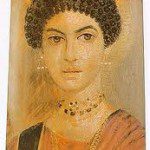Encaustic is a Greek word meaning “to heat or burn in” (enkaustikos). Heat is used throughout the process, from melting the beeswax and varnish to fusing the layers of wax. Encaustic consists of natural bees wax and dammar resin (crystallized tree sap). The medium can be used alone for its transparency or adhesive qualities or used pigmented. Pigments may be added to the medium, or purchased colored with traditional artist pigments. The medium is melted and applied with a brush or any tool the artist wishes to create from. Each layer is then reheated to fuse it to the previous layer.
History of Encaustic
Encaustic painting is an ancient technique, dating back to the Greeks, who used wax to caulk ship hulls. Pigmenting the wax gave rise to the decorating of warships. The use of encaustic on panels rivaled the use of tempera in what are the earliest known portable easel paintings. Tempera was a faster, cheaper process. Encaustic was a slow, difficult technique, but the paint could be built up in relief, and the wax gave a rich optical effect to the pigment. These characteristics made the finished work startlingly life-like. Moreover, encaustic had far greater durability than tempera, which was vulnerable to moisture. Perhaps the best known of all encaustic work are the Fayum funeral portraits painted in the 1st through 3rd centuries A.D. by Greek painters in Egypt. A portrait of the deceased painted either in the prime of life or after death, was placed over the person’s mummy as a memorial. These are the only surviving encaustic works from ancient times. It is notable how fresh the color has remained due to the protection of the wax.
The 20th century has seen a rebirth of encaustic on a major scale. It is an irony of our modern age, with its emphases on advanced technology, that a painting technique as ancient and involved as encaustic should receive such widespread interest.
Earlier attempts to revive encaustic failed to solve the one problem that had made painting in encaustic so laborious – the melting of the wax. The availability of portable electric heating implements and the variety of tools made the use of encaustic more accessible. Today it is gaining popularity with artists around the world.
Care of Encaustic Art
These paintings are extremely archival, but as with any fine art, care should be given to them. There should be no fear of the work melting in normal household conditions. The wax and resin will not melt unless exposed to temperatures over 150 degrees Fahrenheit. Leaving a painting in a car on a hot day would not be advisable or hanging a painting in front of a window with direct desert-like sun. They are also sensitive to freezing cold temperatures.
Some encaustic colors tend to “bloom” or become cloudy over time. If your painting appears indistinct, simply rub the surface with a soft cloth or nylon stocking. Over time the surface retains its gloss as the wax medium continues to cure and harden for up to 1-3 years.

